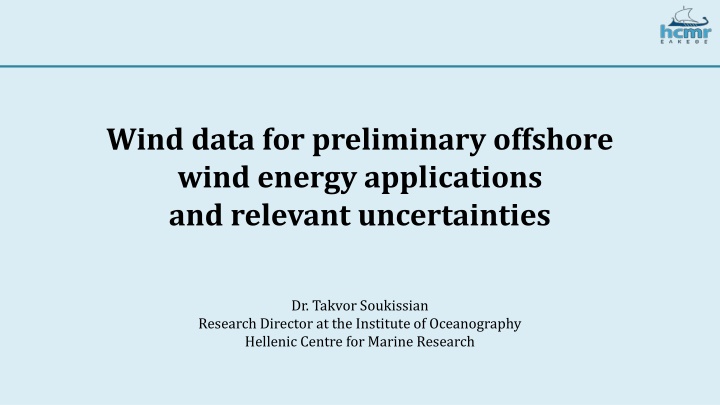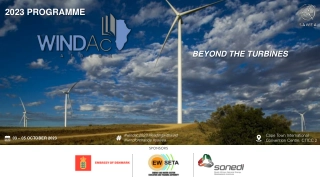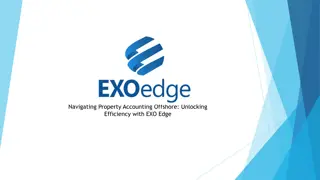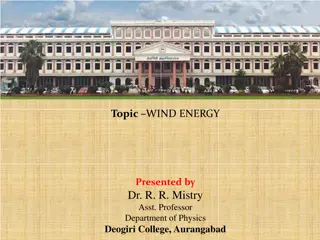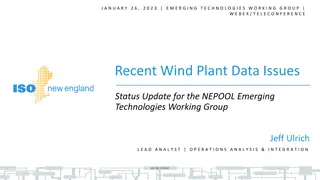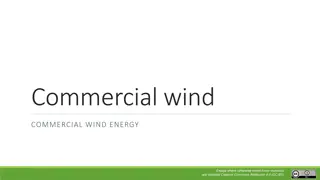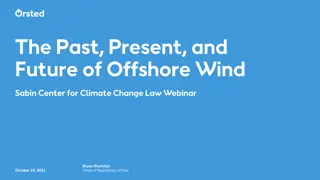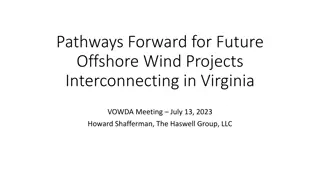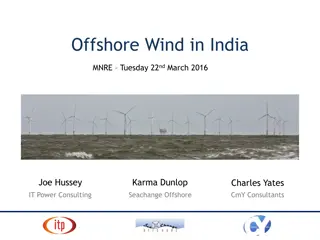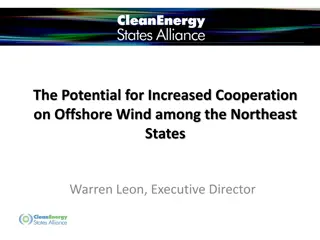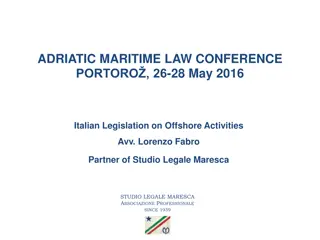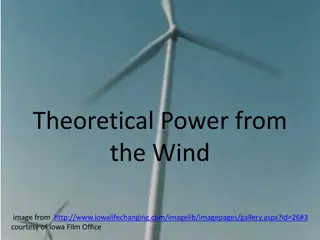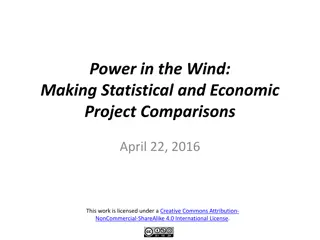Preliminary Offshore Wind Energy Data Analysis
Dr. Takvor Soukissian, Research Director at the Institute of Oceanography, discusses the importance of wind, wave, and sea current data for offshore wind energy applications, along with uncertainties and data sources. Explore the utilization of met-ocean data, in-situ measurements, advantages, disadvantages, and remote sensing techniques like lidar and satellite measurements.
Download Presentation

Please find below an Image/Link to download the presentation.
The content on the website is provided AS IS for your information and personal use only. It may not be sold, licensed, or shared on other websites without obtaining consent from the author.If you encounter any issues during the download, it is possible that the publisher has removed the file from their server.
You are allowed to download the files provided on this website for personal or commercial use, subject to the condition that they are used lawfully. All files are the property of their respective owners.
The content on the website is provided AS IS for your information and personal use only. It may not be sold, licensed, or shared on other websites without obtaining consent from the author.
E N D
Presentation Transcript
Wind data for preliminary offshore wind energy applications and relevant uncertainties Dr. Takvor Soukissian Research Director at the Institute of Oceanography Hellenic Centre for Marine Research
Met-ocean data, sources, and utilization Which parameters are important ? Wind (speed, direction, gust), wave height, period and direction, sea currents (speed and direction) precipitation,humidity, atmospheric temperature,air density, cloudiness, etc. For what types of applications ? Evaluation of wind power density Weather forecasting: Real time, short-term forecast (6 72 hours), medium-term (2 6 months), long- term (decades) Designoptimizationfor offshore wind turbines, especially floating (avoid over- and under-design) Climate change Ship routing weather windows maintenanceactivities, etc. Data sources ? In-situ measurements(oceanographicbuoys, met masts) Ship observations and sensors on-board offshore structures Remote sensingtechniques Numericalsimulationmodels
In-situ measurements Oceanographic buoys Height: 8-9 m, Radius: 1.5-2 m, Weight: ~ 1 tn Energy supply: PVs and batteries. Wind measurements: at ~3 m asl Data transfer: in near real-time (satellite, GSM, VHF/UHF) Meteorological masts Wind measurements at 40-50 m asl or higher throughlidar Highly accurate measurements near the hub height Short measurementdurations High cost The most successful example is FINO3 (an offshore research platform in the North Sea). Wind measurements at 10 min averages with cup and sonic anemometers ranging from 30 to 106 m asl
In-situ measurements ADVANTAGES High reliability of wind, wave and ocean current measurements (measurements are considered as ground truth) Ability to measure at various heights and several parameters at once DISADVANTAGES Lack of information on spatial wind, waves etc., variability Large purchase, installation and maintenance costs Short duration of measurements Data gaps, especially during extreme weather conditions Measurement errors (due to the presence of currents, mooring boats, etc.)
Remote sensing techniques Based on the interaction of electromagnetic radiation with matter (in our case the sea surface) Refer mainly to satellite measurements scatterometers and radiometers Individual satellites cover the earth's surface in specific paths at predetermined periods Data blending from different satellites (e.g., Blended Seawinds) and/or combined with results from numerical models Lidar & Sodar: Remote sensing systems based on the exploitation of the Doppler effect with visual and sound signals, respectively with main instruments
Remote sensing techniques ADVANTAGES Extended spatial data coverage If there is lack of in-situ measurements, remote data are considered as the next most reliable source No data gaps DISADVANTAGES Uncertain quality of measurements at the land-sea boundary Errors in converting satellite signals to the corresponding wind values and interpolation to produce gridded wind data
Numerical simulation models A "closed" system of equations that model the evolution of atmospheric, wave and ocean circulation phenomena. This is done by translating the physics to mathematical equations through discrete points (grids) at specific levels Hindcast/reanalysis: numerical reconstruction of wind conditions based on past information. Enrichment of historical data with information now available. This type of products is mainly used today in preliminary offshore wind energy assessment Forecast: prediction of atmospheric and sea-state conditions in a given area
Numerical simulation models ADVANTAGES Very large spatial data coverage Very long time series No data gaps DISADVANTAGES Uncertainties due to model errors (e.g., parameterization errors, low accuracy of initial and boundary conditions, numerical instabilities)
Source of errors that cause uncertainties Spatial and temporal interpolation errors: In order to fill spatial and temporal gaps (lack of data) various interpolation methods are used that raise additional errors. Errors due to models and numerics: models are approximations of the physical reality, while translation of mathematical models into a computer may also cause numerical instabilities. Parameter uncertainty: A striking example for this case is the use of the Weibull distribution and its parameters in wind energy calculations, instead of using directly the available data! Weibull is rarely suited for wind speed distributions!!!
Pros and cons of popular numerical simulation products Global Wind Atlas Ver. 3 (more or less same remarks for NEWA) 1) High spatial resolution of 3 km (WRF model with forcing from ERA5) combined with WAsP microscale model Highly user-friendly presentation of the particular area wind energy statistics It is a free, ready-to-use product It demands almost no work to produce results Results are provided at several appropriate levels 2) 3) 4) 5) 1) Short time series length (only 10 years) 2) No info on instantaneous values of wind speed and therefore lack of knowledge of extreme wind states 3) Validation only for Pakistan, Papua New Guinea, Vietnam, and Zambia 4) Vertical extrapolation of the wind profile in WAsP is based on the log-law
Pros and cons of popular numerical simulation products MERRA-2 1) Validated for several locations around the globe both on-shore and offshore 2) Very long-time series lengths resulting in more reliable estimations of variability, extremes and weather windows 3) Temporal resolution: 1 hour 4) Conditions at various levels are purely based on physics (not the log-law!) 5) Full time series and raw data are freely available 1) Output winds only at 10 m and 50 m asl 2) Data processing and analysis is demanding for the non-experienced user 3) Spatial resolution: 0.625 0.5
Pros and cons of popular numerical simulation products ERA5 1) Validated for several locations around the globe both on-shore and offshore. ERA5 performs in general better than MERRA-2 2) Very long time series lengths (1959-2022, on-going) resulting in more reliable estimations of variability, extremes and weather windows 3) Temporal resolution: 1 hour 4) Conditions at various levels are purely based on physics 5) Full time series and raw data are freely available with output winds at 10 m and 100 m asl. 6) Product supported by EU Copernicus and ECMWF 1) Data processing and analysis is demanding for the non-experienced user 2) Spatial resolution: 0.5 0.5
Final remarks ERA5 outperforms MERRA-2 for wind power simulation Global Wind Atlas bias correction does not consistently reduce the error (*) Global Wind Atlas (ver. 2) can be used for bias correction (*) Bias between observed and simulated wind power strongly depends on location (*) The Global Wind Atlas does not provide a substitute for individual country-based wind atlases or wind resource assessment conducted commercially for wind farm developers. Those kinds of assessments require a higher precision, specific configuration for the region in question, and a more stringent validation phase (**) The wind atlas that aligns the most with actual measurement is the New European Wind Atlas (***) (*) K. Gruber, P. Regner, et al., 2022, Towards global validation of wind power simulations: A multi-country assessment of wind power simulation from MERRA-2 and ERA-5 reanalyses bias-corrected with the global wind atlas, Energy, Volume 238, Part A, https://doi.org/10.1016/j.energy.2021.121520 (**) Badger, J., Hahmann, A., Lars n, X. G., Badger, M., Kelly, M., Olsen, B. T., & Mortensen, N. G. (2015). The Global Wind Atlas: An EUDP project carried out by DTU Wind Energy (***) Joel Thomas, 2021, Comparative Analysis Of Wind Atlases: Wind Resource Assessment Of Forested Sites For Wind Power Development, Uppsala University, Master Thesis
Thank you tsouki@hcmr.gr
Uncertainty Uncertainty refers to situations involving imperfect or unknown information. Uncertainty is present in both measurements and simulations and should be quantified at a reasonable probability level ! Main measure of uncertainty is the confidence interval Propagation of uncertainty is the main problem in wind energy applications. An erroneous value for wind speed multiplies the error in wind energy/power calculations
